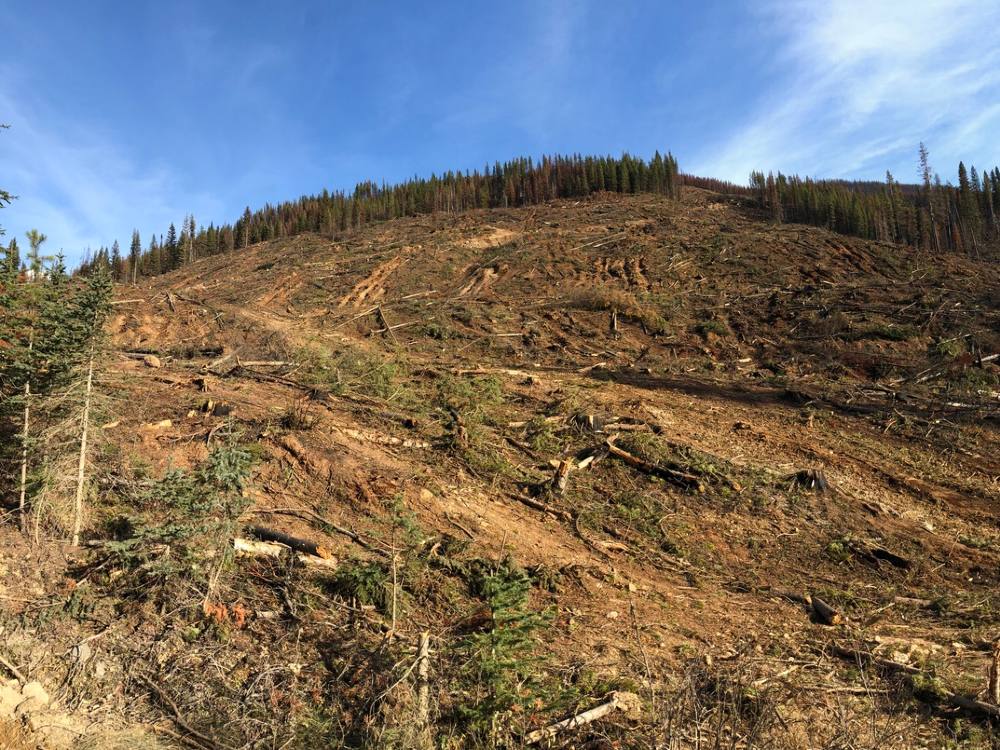B.C.'s cornerstone forest regulation, the annual allowable cut, sets out how many trees can be cut down each year with the intent of sustaining the industry for years to come.
But a legal loophole can allow companies to log beyond the limit for years with no repercussions.
In an email chain uncovered through a freedom of information request by The Tyee, Diane Nicholls, the province’s former chief forester, acknowledged the problem.
The province’s allowable cut is “sustainable at set levels,” she wrote.
But the government’s “tenure allowances” which set forest company logging levels are “completely out of whack” with the annual allowable cut assessments, Nicholls wrote.
The AAC is based on an assessment of the current conditions — in other words, the trees on the ground — and sets sustainable harvest levels based on assumptions about considerations like how fast trees grow. Around every 10 years, for each region, the chief forester sets a new annual allowable cut limit, aiming to sustain the sector for decades.
But that decision itself has no direct impact on logging companies’ activity in timber supply areas.
In order for the allowable cut limit to become meaningful, the province needs to portion out chunks of the allowance to future license holders — a step called “apportionment.” For current license holders, it needs to carry out another step called a “license reduction.”
While adjusting the allowable cut every decade or so is a legal mandate for the chief forester, these second and third steps — the ones that make the allowable cut meaningful — are under the jurisdiction of the minister of forests, and are not legally required.
When it comes to current licenses, the province does not publicly disclose if, when or how many have been reduced to match updated allowable cut levels. In an email response to a query from The Tyee, the province said it was possible to see year-to-year permit changes by comparing annual license tables, but these tables don’t specify whether reductions have been made in response to changes to the annual allowable cut.
“It takes considerable time to meaningfully engage with all affected parties in order to achieve fulsome decisions,” the Ministry of Forests told The Tyee via email. The statement added that the apportionment or license reduction step requires “government-to-government discussions with applicable First Nations in order to move forward on key reconciliation objectives and goals.”
But Mike Morris, BC Liberal MLA for Prince George-Mackenzie, suggests that major forest companies play a central role in the holdup. “It really requires all the licensees to agree on an apportionment,” he said. “And most times they can't agree.”
Since writing that 2021 email, Nicholls left her position as chief forester and is now vice-president of sustainability, North America, for multinational Drax, the province’s largest wood pellet company. The company did not respond to The Tyee’s request for comment.
In their emailed statement to the Tyee, the Ministry of Forests also said that delays in apportionment do not pose a threat to forest sustainability, because the allowable cut limit is generally higher than levels at which companies want to log. “In the majority of management units the annual harvest is below the level of the AAC,” the email said.
And if companies are logging less than the AAC, it makes sense to avoid allocating future tenures through the apportionment process, said Garry Merkel, a registered forester and member of the province’s Old Growth Technical Advisory Panel. “Not allocating timber, and having undercut is not a bad thing,” he said, noting that having unallocated timber “gives us more flexibility” to deal with the transition towards healthier forests.
But by failing to reduce tenures to match the AAC, companies in some regions could log above the current limit, if they wanted to.
According to the province, companies log about 25 per cent fewer trees than the annual allowable cut sets as a threshold.
In the Prince George Timber Supply Area, companies logged about 16 per cent less than the limit for four years, even though companies’ tenures were still based on the old annual allowable cut, which is 40 per cent higher than the current limit.
Similarly, the 100 Mile House timber supply area’s allowable cut was reduced in 2018, but the province still hasn’t changed the tenures of licensees. That means that, in practice, the allowable cut for many companies’ tenures are still set at a level determined in 2013 — more than twice the volume of the current limit. But similar to Prince George, companies are logging below that, even though their permits allow them to log more.
In the Cranbrook timber supply area in the Kootenays the tenures have not been adjusted to match the allowable cut since it was reset in 2017. But there, too, logging remains below the current limit.
“There doesn't seem to be that urgency” when it comes to aligning permits with the annual cut, said Eddie Petryshen, a conservation specialist at Wildsight, a conservation-focused charity, and a Kootenay resident, who added that AAC calculations are also often delayed beyond the stated 10-year renewal period. “There seems to be a bit of a pattern there with the analysis branch seemingly not being able to keep up,” he said.
If logging over the lifespan of the allowable cut decision, generally 10 years, exceeds the stated limit, the ministry says it has safeguards in place, noting that “the chief forester will consider actual amount harvested for the period when the AAC is redetermined and may redetermine the AAC sooner if actual harvest levels posed a risk to the sustainable timber supply.”
But Petryshen believes the provincewide gap between harvest levels and the annual allowable cut signals that the limit should be reduced — not that it doesn’t need to be enforced.
“That overarching issue is that these AACs are just not sustainable, and they’re not attainable for the industry as well as the ecosystem,” he said.
In fact, says Petryshen, those high limits are helping to precipitate the crash in B.C.’s forests that has been long predicted, where the industry simply runs out of trees to log. “We’re digging the hole deeper,” he said.
The ‘falldown effect’
B.C.’s emerging harvest crash is linked to a phenomena called the “falldown effect,” says Ben Parfitt, resource policy analyst with the B.C. office of the Canadian Centre for Policy Alternatives. Since the mid-1800s, B.C. has logged its primary forests faster than regrown forests could grow big enough to provide an economic substitute. The “falldown effect,” as defined by the province, describes that in-between stage, where logging leads to a lack of economically viable trees, triggering a decline in the industry.
“Simply put, too much forest has been logged too quickly,” said Parfitt. He noted that during the past two years, which have had record-high lumber prices, companies still failed to log their share of the allowable cut.
This is particularly pertinent in the Interior of B.C. said Parfitt, where extensive logging occurred later than in forests closer to the coast, meaning there are few viable second and third growth trees to log. That scarcity was compounded by the province’s decision to increase the allowable cut to account for the pine beetle outbreak, he said.
“We are on the cusp, in the Interior of British Columbia, of seeing a crash in logging rates that will be jaw-dropping in scale,” he said. “If you continue to allow logging rates to be in excess of what can be regrown, you are potentially setting up communities for a very, very hard landing.”
The allowable cut’s projections about how much and how fast trees can regrow are an imprecise science, Morris said, adding that he believes the AAC often overestimates growth rates in monoculture forests where trees are planted close together, and underestimates the impacts of pests on taking eligible forest out of timber harvesting land base.
He said he’d driven to areas in the Prince George region which provincial models labelled as healthy, harvestable forests, only to find forest that has already been logged.
“It's just not there,” he said.
The health of animal populations also sends up red flags about forest depletion, Morris added.
“We have gotten to the point now where our wildlife populations are in serious decline,” he said. “Our raptors are disappearing. I haven't seen a goshawk or a great horned owl up in my area for the last 10 or 15 years. And they used to be prolific.”
The province’s forestry regulations allows government to take biodiversity considerations into account when implementing allowable cut decisions, but only insofar that those considerations don’t “unduly impact” the industry’s access to timber.
For a process built on speculation, Morris says delays in enforcing the allowable cut only worsen the problem, noting that AAC’s 10-year calculations are based on information gathered years before they are determined.
“Then it takes another four or five years for the apportionment to get handed out to everybody,” he said. “By that time, you're probably 15 years past the validity of the data and the information that was fed into the system that started the whole process in the first place.”
“They’re behind the eight ball,” he said.
With substantial reduction of allowable cut limits on the horizon in order to adjust to the realities seen in B.C.'s forests, Parfitt added, government needs to act quickly to drop the allowable cut, which also means reducing the number of trees companies are legally allowed to cut down.
“If they don't do that, then they're simply setting up an even more calamitous fall down than the one that we're already confronted with,” Parfitt said. ![]()
Read more: BC Politics, Environment
















Tyee Commenting Guidelines
Comments that violate guidelines risk being deleted, and violations may result in a temporary or permanent user ban. Maintain the spirit of good conversation to stay in the discussion and be patient with moderators. Comments are reviewed regularly but not in real time.
Do:
Do not: